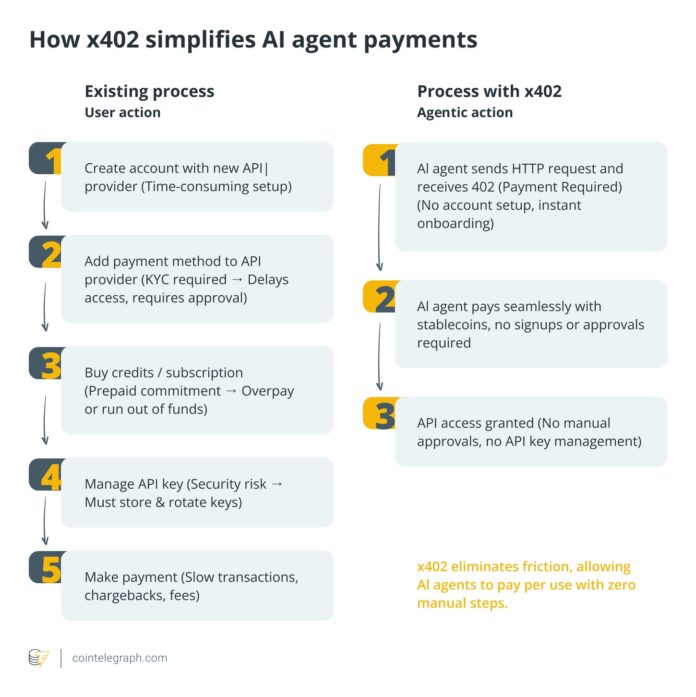Introduction to x402: The Pay-Per-Use Protocol
x402 is a revolutionary protocol that enables pay-per-use functionality on the internet, allowing users to access paid applications, APIs, and files without the need for accounts, passwords, or monthly plans. The protocol has gained significant momentum, driven by infrastructure development and adoption by major players such as Coinbase and Cloudflare.
Key Takeaways
The x402 protocol has several key benefits, including enabling pay-per-use functionality, driving infrastructure development, and providing a straightforward way to test and implement the protocol. The current momentum is driven by Coinbase and Cloudflare, with PING serving as a catalyst for the protocol’s adoption. Additionally, the protocol’s focus on actual usage rather than price charts is driving a second wave of adoption.
-
x402 enables pay-per-use functionality on the Internet.
-
The current momentum is infrastructure-driven and driven by Coinbase and Cloudflare.
-
PING was a catalyst, but the real story is the protocol adoption, not the token.
-
You can test it quickly by spinning up an endpoint and checking the 402 → Pay → Grant flow.
How x402 Works
x402 is a simple handshake that allows users to access paid content without the need for accounts or API keys. When a user accesses a paid URL, the server responds with a “402 Payment Required” message, indicating the price and recipient of the payment. The user sends the on-chain payment from their wallet, repeats the request, and the server delivers the result.
The Second Wave of x402 Adoption
The idea of x402 is not new, but the protocol has gained significant momentum in recent years, driven by the release of documentation and code by Coinbase and the launch of the x402 Foundation initiative by Cloudflare. The protocol’s focus on actual usage rather than price charts is driving a second wave of adoption, with new tools for AI agents that can pay automatically.
Did you know? X402 is becoming the standard way for AI agents to pay for things themselves. Cloudflare adds native x402 support to its Agents SDK and MCP servers. Coinbase’s new payment MCP allows popular major language models to manage a wallet and process requests without an API key.
What is PING and How Does it Relate to x402?
PING is a memecoin that was launched on Base (Coinbase’s Layer 2) and was the first public token minting to be executed over an x402 flow. The token was launched by the X account Ping.observer and served as a catalyst for the protocol’s adoption. While the token’s price has fluctuated, the lasting impact was not the token price, but the influx of developers and endpoints experimenting with x402.
Did you know? PING reached an all-time high of around $0.0776 on October 25, 2025, before declining again in the following days.
Testing x402: A Quick Start for Developers
Getting Started
x402 is a simple handshake that allows users to access paid content without the need for accounts or API keys. To test x402, developers can choose from two setup options: managed or DIY/specification.
-
Managed: Use Coinbase’s hosted x402 gateway with dashboards and built-in Know Your Transaction (KYT) checks. It is ideal for a quick proof of concept.
-
Do it yourself (DIY)/Specification: Clone the open source x402 reference implementation and run a minimal seller and buyer locally if you want full control.
Making a Paid Endpoint Available
Choose any route (e.g. “/inference”). If someone accesses it without paying, send back a “402” response along with the payment details, including amount, balance (USDC), destination address, and expiration date. If you can trigger this response with “curl”, you are speaking x402 correctly.
Completing a Paid Request
Use the sample client or managed gateway to detect the 402, make the on-chain payment, and then retry the request. Access should be automatically updated once payment is confirmed, without the need for accounts, API keys, or OAuth.
Testing with an AI Agent
If you’re working with agents, start the Model Context Protocol (MCP) sample. The interceptor detects the “402,” makes the payment from the agent’s wallet, and automatically reissues the request. This is a quick way to confirm agent-to-endpoint flows.
Top tip: Start with a testnet as described in the quickstart. Once the 402 → Pay → Grant loop is stable, switch the configuration to mainnet.
Risks, Timelines, and What to Consider Next
What Else Could Go Wrong?
x402 is still relatively new, and the specification and reference code may continue to evolve. Most live setups currently use USDC, which creates the risk of vendor and asset concentration. It is also important to separate token narratives from protocol progress.
Governance to Track
Pay attention to the x402 Foundation’s official launch details, including its charter, membership list, and roadmap. This event marks the transition of the protocol from a product to a standard. Also keep an eye on Cloudflare’s developer ecosystem (Agents SDK and MCP), as mainstream tools often face widespread adoption.
Adoption Signals
Look for real endpoints that return “402” responses with payment parameters and then unlock access after an on-chain payment, without the need for accounts or API keys in between. More quickstarts, documentation, and GitHub activity are positive indicators on the supply side.
This is How You Stay Up to Date
Follow primary sources: Coinbase’s product pages, documentation, and GitHub for protocol updates, and Cloudflare’s blog and press releases for Foundation news and SDK support. Treat anything outside of these channels, especially token chatter, as background noise.
This article does not contain any investment advice or recommendations. Every investment and trading activity involves risks and readers should conduct their own research when making their decision.
For more information on x402 and its adoption, visit https://cointelegraph.com/news/why-the-x402-protocol-didn-t-fade-after-the-ping-hype-and-what-s-driving-the-second-wave?utm_source=rss_feed&utm_medium=rss_category_analysis&utm_campaign=rss_partner_inbound

